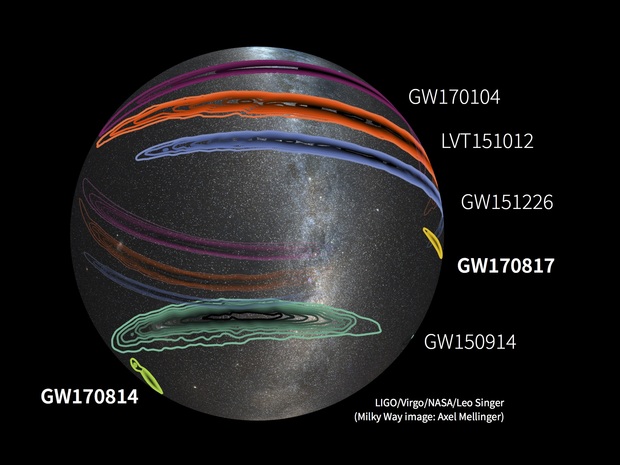Gravitational Wave Followup Overview
Welcome to the NED Gravitational Wave Follow-up (GWF) Service
The purpose of this NED service is to facilitate searches for electromagnetic (EM) counterparts to gravitational wave (GW) events. Within minutes after the International Gravitational-Wave Observatory Network (IGWN; that currently includes LIGO, Virgo, KAGRA) issues an alert using the General Coordinates Network (GCN; https://gcn.nasa.gov/↗) operated by the NASA, this service responds by cross-matching in 3D the event's HEALPix map with the galaxies in the local Universe and the following results are provided: an all-sky image of the probability contours, the location of all galaxies in NED within the event's 90% probability volume, and the top 20 galaxies sorted by the joint 3D and WISE W1 luminosity probabilities (P_3D*P_LumW1). To get started, click on "Events" in the menu above or simply click on the (blue) button below for the most recent GW event.
Overview

We have now entered the era of gravitational wave astronomy and started to explore the Universe through this new window. Our understanding of these events is greatly enhanced by identifying and studying their EM counterparts or host galaxies, a field known as multi-messenger astronomy (MMA). The sky localizations for GW events detected by IGWN are generally large (>10 square degrees; see Figure 1), making this task very challenging. However, an effective strategy to increase the efficiency of observational follow-up campaigns is to search for kilonovae or afterglows by targeting galaxies in the highest probability volume of the GW event.
This service exploits the rich and constantly growing content of the NASA/IPAC Extragalactic Database (NED) to help astronomers around the world to efficiently search for the EM counterparts to GW events. A list of galaxies in the local Universe is constructed by using available redshift and redshift-independent distances (see below for a description). Prior to January 2020, a distance of 200 Mpc was used to define the NED local Universe sample in order to match the targeted sensitivity of GW detectors to binary neutron stars (BNS). However, several BNS and neutron star-black hole (NSBH) events occurred during the IGWN O3 run beyond 200 Mpc. Consequently, we have increased the distance limit of the NED local Universe sample to 1 Gpc to provide coverage of future events. We remind users that the availability of galaxy distances and redshifts are increasingly incomplete at greater distances, as further described below. Also, if an event's mean distance minus 1 standard deviation is greater than the NED-GWF distance cut of 1 Gpc the galaxy cross-match is not performed and no galaxies are provided.
An overview of the process is described here. The NED GWF service listens to public alerts on the General Coordinates Network (GCN)↗, which is used by IGWN to distribute GW event information. After each GW event, the HEALPix map is cross-matched in 3D to the NED galaxy list using the methodology of Singer et. al (2016)↗. During this process an all-sky image of the probability contours, the location of all galaxies in the 90% volume, and the top 20 galaxies sorted by the joint 3D and WISE W1 luminosity probabilities (P_3D*P_LumW1) are displayed on each event's page.
The prioritization of galaxies chosen currently is based on the only host of a BNS event known to date (GW170817), which is a massive early-type galaxy (NGC 4993; Coulter et. al (2017)↗). Theoretical studies indicate that BNS events are likely to occur in more massive galaxies due to long merger delay time (>1 Gyr; e.g., Dominik et. al (2012)↗). We have chosen the WISE W1 luminosity as this light closely traces the older stellar population of a galaxy and hence is a proxy for stellar mass (Jarrett et. al (2013)↗). However, the expected host population of BNS events is still debated in the literature (e.g., Nugent et. al (2022)↗). Thus, we provide additional pre-computed prioritization metrics (star formation rate, P_3D*P_SFR; stellar mass, P_3D*P_Mstar; and specific star formation rate, P_3D*P_sSFR) which are available via downloading the entire galaxy list inside the event's probability volume.
Galaxies in the NED Local Volume Sample (NED-LVS)
NED-GWF uses a subset of ~2 million objects in NED with distances out to 1000 Mpc, where the distances are selected based on both redshifts and redshift-independent distances. Galaxy clusters, galaxy groups, and components of galaxies are omitted to keep the sample confined to candidate host galaxies for GW events. In addition, photometry from all-sky surveys (GALEX, 2MASS, and AllWISE) that have been joined into NED are also extracted, with ~90% of NED-LVS objects having at least one measurement. These fluxes are used to derive physical properties (SFR and stellar mass) and to estimate the completeness relative to expected local luminosity densities. For more details or to download the entire sample please go to the NED-LVS webpage (click the button below) and see the corresponding publication Cook et. al (2023)↗.
Automated Access to NED-GWF Galaxy Lists (API)
The NED-GWF service includes a web application program interface (API) that provides scriptable access to galaxy lists and visualizations for IGWN events. For example, to retrieve the full list of galaxies in the second analysis (Pkt_Ser_Num=2) of the event S200129m with a FITS file format use: https://ned.ipac.caltech.edu/uri/NED::GWFglist/fits/S200129m/2. For more details, go to the NED-GWF Web API page.
June 2, 2025 Update
- The NED-GWF code was updated to ingest sub-solar mass (SSM) events now being provided by the IGWN collaboration. The "GW Event Information" table on an event's page will now include "HasSSM", which is the probability that at least one of the compact objects has a mass less than one solar mass.
- The NED-GWF events page now organizes the fourth observing "Run" into their appropriate O4a, O4b, and O4c. For specific date ranges see Table 2 of the "Data Management Plan" document here.
- Beginning June 2, 2025 NED-GWF utilizes an updated version of NED-LVS (June 2025) which includes new objects ingested by NED from the literature and the removal of newly identified non-galaxy contaminants. This updated version contains a total of 2.10M objects, an increase of 33K (1.6%) over the previous version. Click on the "NED-LVS Description and Download" button above for more details.
Previous Update History
Feb 10, 2025 Update
- Beginning Feb 10, 2025 NED-GWF utilizes an updated version of NED-LVS (January 2025) which includes new objects ingested by NED and the removal of newly identified non-galaxy contaminants. This updated version contains a total of 2.07M objects, an increase of 203K (10%) over the previous version, where 85% of newly ingested data originate from the Dark Energy Spectroscopic Instrument Early Data Release (DESI-EDR; DESI Collaboration, 2024↗). Click on the “NED-LVS Description and Download” button above for more details.
May 29, 2024 Update
- A fix was applied to the code that computes joint probabilities for candidates within the GW event volume weighted by the galaxy properties. In NED-GWF event reports prior to 2024 May 29, incorrect probability densities affected the "P_3D" column and subsequent joint probabilities: "P_3D_Mstar", "P_3D_SFR", "P_3D_sSFR", and "P_3D_LumW1". This affected the order of candidates in the list, where some galaxies with lower 3D probability densities were given higher weights. The composition of the galaxy list in each event's volume, and the probability density per volume ("dP_dV") calculations for each galaxy were correct. To avoid confusion, going forward the "P_3D" column is renamed to "P_3D_csum" representing the cumulative sum of the probability densities, and "dP_dV" is renamed to "P_3D" to represent the probability density per volume (Prob/Mpc^3) as originally intended. In reports generated prior to 2024 May 29, correct joint probabilities can be obtained by multiplying the previous "dP_dV" column and the desired galaxy property probability (e.g., P_LumW1, P_Mstar, etc.).
April 8, 2024 Update
- Added a semi-transparent band in the all-sky images that represents the Galactic plane.
- For easier access to events, those that occur in the first (O4a) and second (O4b) half of IGWN's fourth observing run have been separated on the event's page drop-down list.
Acknowledgments
This service makes use of the General Coordinates Network (GCN) operated by NASA, and of the Python package ligo.skymap↗ written by Leo Singer (NASA/GSFC). We thank Leo Singer for his helpful comments and feedback.
Citation of NED-GWF
If you use the NED-GWF service please cite the Digital Object Identifier (DOI): 10.26132/NED3.






